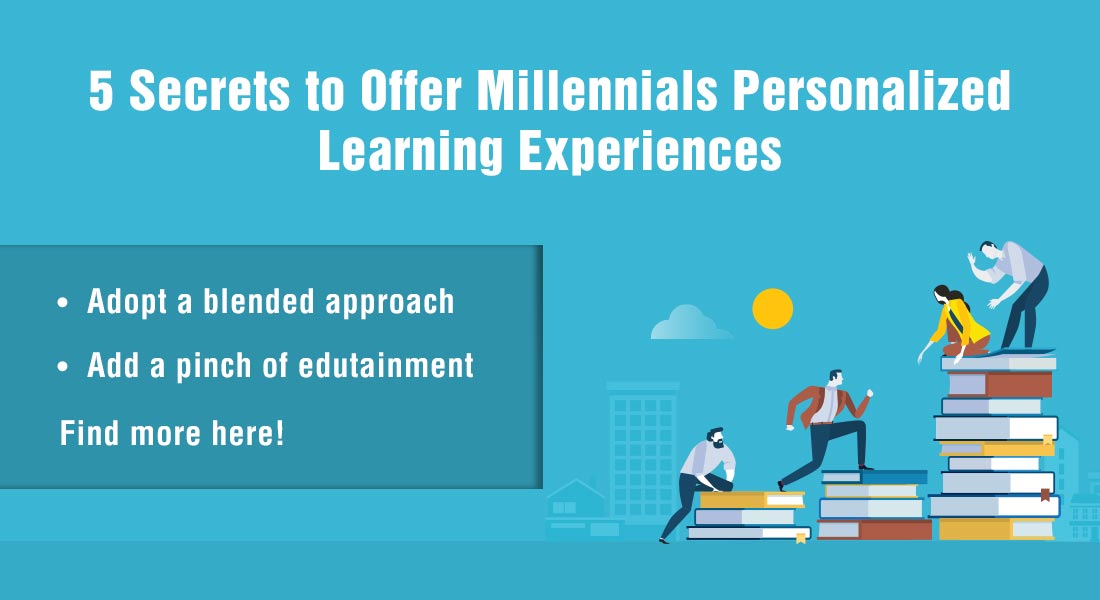Personalized Learning: 5 Ways to Engage the Millennial Workforce

Personalization – that’s a word that keeps popping up quite frequently in conversations nowadays. From gift cards to concept cars to custom shampoos, almost everything in the market today is being promoted as being ‘personalized’. And why not? We all want something unique, something special, something tailormade – just for us. And when such a concept is leveraged for corporate training, learning can become interesting, and more importantly, very effective. After all, personalized learning aims to customize training content, the learning environment, and the training delivery method to fit each individual learner’s needs.
How to Build Personalized Learning Experiences for the Millennials
- Adopt a blended learning approach
- Incorporate self-directed learning elements
- Build social engagement for collaborative learning
- Add a dose of edutainment
- Use AI and learning analytics
And before you scoff at the idea and say why go through all the trouble to personalize learning when your usual training programs have worked perfectly for so long, I will just say one more word – Millennials.
Explore tips, tools, and solutions to generate excitement and motivation in virtual classrooms.
As marketing strategist Paul Gillin says,
“Personalization is pointless without knowing the individual. Understand the dreams, hopes, and fears that motivate your customers then hit them where it counts.”
Considering your millennial learners are your customers, are you ready to get to know them better?
What Do Millennials Want from Corporate Training?
According to a Gallup research report, 55% of corporate millennial workers claim that they are not engaged in their work! That is both shocking as well as disturbing considering they currently represent a growing demographic in the workplace. Statistics like these are met with a lot of grumbling and exasperated questions like “What more do millennials want?” And if you’re wondering if they really are different from the previous generations, the answer is ‘yes!’ You need to understand why millennials are different to understand what millennials want.
Millennials were born at the turn of the millennium (between 1981 and 1996), at the turn of an era, from analog to digital. They grew up rubbing shoulders with globalization (economic as well as cultural), in the Internet age (that made thoughts and ideas from across the globe accessible for everyone), in the age of the mobile phone (that made the world a global village). Is it really surprising that millennials are so different from the generations before them?
Millennials are a product of the digital age and they bring that shift to the workplace. They have very high expectations from their job or training (and won’t lower them!), and will keep challenging the status quo. While battling prejudices and accusations about being lazy, entitled, or easily distracted, they also bring new vigor and energy to the workplace. Studies show that they like having a unique purpose in their job, care about fixing their weaknesses as much as developing their strengths, and most importantly, want personal development through work.
So now the question is, are you ready to create a personalized learning program to meet your millennial learners’ training requirements?
5 Ways to Build Personalized Learning Experiences for the Millennial Workforce
1. Adopt a Blended Learning Approach
After all this talk about millennials belonging to the digital age, to suggest blended learning as an effective way to personalize learning may seem a bit surprising. That’s because we tend to think of blended learning only as a mix of classroom instructor-led training and online training But the truth is that blended learning as a strategy can blend all types of learning methods, both online and offline. It can include classroom ILT, Virtual ILT (VILT), eLearning, social learning, guided learning through mentoring, coaching, and more.
Blended learning with its eclectic mixture of learning solutions appeals to the millennial learner because it gives them different types of learning experiences along with the flexibility to choose how they would want to learn. By opting for a blended learning strategy, you not only leverage the benefits of eLearning to train your millennial workforce, but can also offer them face to face learning experiences when needed through classroom ILT or VILT. You can also provide them learning experiences outside formal training through social learning opportunities.
Adopting a blended learning approach and providing a wide variety of content in different formats can allow millennial employees to engage with learning materials in a way that works best for them.

2. Incorporate Self-directed Learning Elements
We all know that adult learning is most effective and successful when it is self-directed. But if you look at most corporate training programs, you’ll find very little is in the learner’s control. They are assigned training (whether eLearning or classroom) by the management and they don’t have much say in how and what they learn.
While it is required for you to maintain some control over your employees’ training, it doesn’t mean learners don’t get a few opportunities for self-directed learning. After all, allowing learners flexibility in their training can make for a personalized learning experience.
Here are a few ways you can incorporate self-directed learning elements in corporate online training.
- Allow learners easy access to courses in the Learning Management System (LMS) outside of what they are officially assigned.
- Use advanced experience settings in modern learning platforms to recommend courses to learners based on their interests and prior search history.
- Leverage the power of mobile learning to enable anytime, anywhere learning, across mobile devices.
- Use multiple microlearning formats to deliver the same learning content to let learners choose their preferred format of training.
3. Build Social Engagement for Collaborative Learning
Whatever else you may think of millennials, you can’t deny the fact that they are a social generation. Any form of social learning opportunity encourages one-on-one interaction between learners, instructors, and their peers, enabling a personalized learning experience. Moreover, it reduces the excessive focus on formal training, allowing learners to learn informally.
Collaborative learning can be integrated into the training program by using discussion boards, online forums, chat boxes, online forums, and communities. Using social media platforms to create event pages and promote short learning modules can also help encourage social learning.
4. Maintain the Level of Edutainment
Now we come to a point that is the cause of most of the arguments against millennials’ workplace attitude – their propensity to have fun. Traditionally, it was always believed that workplace training and fun are mutually exclusive, and also that fun is detrimental to employee productivity. But if you think about it carefully, that doesn’t make sense, does it? After all, fun activities make tasks interesting and enjoyable and in turn, make us more dedicated to work.
That is the reason why millennials advocate edutainment (education + entertainment). It makes learning effective and engaging at the same time. But does it make for a personalized learning experience?
Well, what is the most popular way of incorporating edutainment in corporate online training? It’s through gamification and game-based designs. Both these strategies give learners an opportunity to face challenges, gain rewards, and compete while learning. Elements like avatars are often used in game-based eLearning, adding even more personalization.
5. Use AI and Learning Analytics
Now we come to the heart of the matter. While all the previously discussed ways can be counted as personalizing elements, they do not make learning truly personalized. Only adaptive learning can give learners a truly personalized learning experience, with the help of advanced AI technology and learning analytics.
Adaptive learning is a smart learning strategy that aims to deliver personalized learning pathways for individual learners by tracking and analyzing their learning activities in real-time. Learning analytics allows you to track learners’ actions during their learning journey and analyze them to know their training preferences, knowledge gaps and strengths, topics of interest, and much more. Feeding this data in an AI-based algorithm will process the data in real-time and provide personalized learning pathways that are tailormade for individual learners.
While the use of AI is still very limited in corporate L&D, learning analytics is gaining a lot of popularity in recent years and can help you take the first steps toward personalized learning.
Summing it Up!
There’s a popular saying, “all fingers are alike but they are not equal.” Dealing with millennial learners certainly proves that. For a long time, it was thought that corporate training needed to be very formal and rigid in its design as well as delivery. However, that thinking has to change if you want to train millennials effectively. Millennials value personalized learning experiences and considering how effective it is in corporate training, what are you waiting for?
I hope the different ways of building personalized learning experiences for the millennial workforce discussed in this blog have given you some insights into how you can improve your training program. If you want to know more about effective eLearning design for new-age learners, download our free eBook.
Editor’s note: This post was originally published in July 2020 and has been updated for comprehensiveness.




![5 Amazing Benefits of Personalized Online Onboarding training [Infographic]](https://blog.commlabindia.com/hubfs/Imported_Blog_Media/elearning-for-effective-onboarding-1.jpg)
